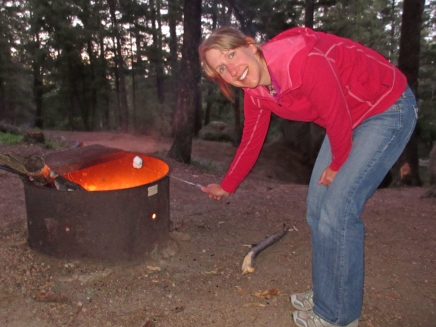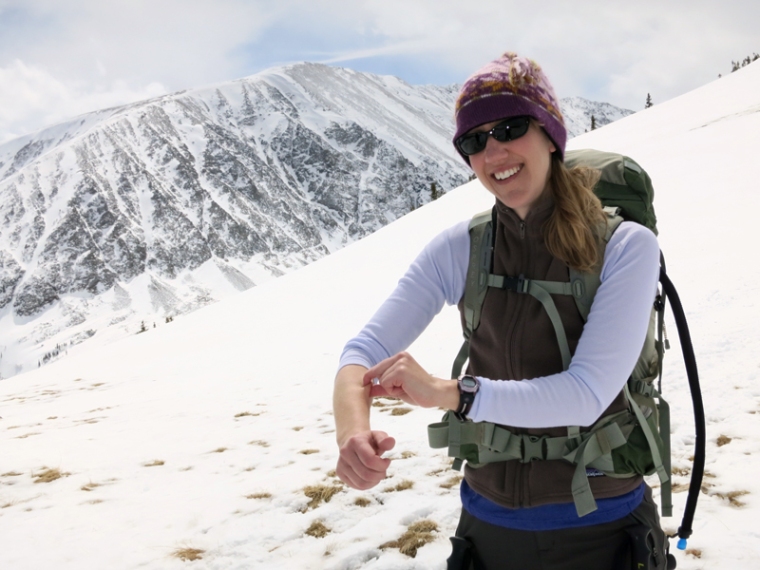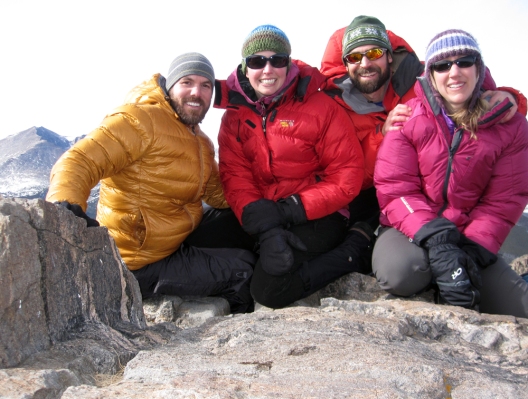The main room of our condo during a recent vacation with Doug’s parents looked a bit like an outdoor gear store. Snowboards and skis of all sorts lined the wall and a plethora of boots sat in front of the fireplace. Closets, dressers and duffel bags overflowed with Capilene, fleece and Gore-tex clothing. During a week in the mountains near Winter Park, Colorado, we took part in two days of biathlon racing, and one day each of skate skiing, snowboarding and telemark skiing. I also managed to squeeze in some hiking and sketching in my nature journal in Rocky Mountain National Park. With so many activities on the schedule–some of which required an early start–it was hard to know when to fit in my appliance changes.




Unfortunately, appliance changes aren’t that quick for me. Due to pretty acidic ileostomy output, I have to protect my skin with several layers of products. Stoma powder, skin prep, Duoderm, Eakin Seals and paste–I use them all. My changes usually take at least 30 minutes–sometimes longer. Even when I use all those products, my output chomps through them like a piranha if I try to go longer than three or four days, and I end up with very raw and painful skin.

Those with an ileostomy know that it can be pretty hard (if not impossible) to find even a short chunk of time when your stoma isn’t pooping. Usually I try to change my appliance in the morning as that is when my stoma is the most quiet. However, on a busy ski vacation (or any time with a full schedule) that plan doesn’t always work. If I already have to wake up at 5 a.m. to make it to a race on time or catch first tracks in powder, it is hard to get up even earlier to fit in an appliance change. Also, I don’t like worrying about when I am eating and how it will impact my appliance swap. If I want to head out to a restaurant for a post-ski meal later in the evening, I go for it even if I know it will be harder to change in the morning due to the extra output. In some cases I will even switch out appliances in the evening right after a big dinner (gulp!) if that is the best way to fit it into my schedule.
If you are wondering if I have a particularly quiet and cooperative stoma, the answer is no. My stoma is a non-stop workhorse and churns out output 24/7. Fortunately, I have some tricks that allow me to change at any time of the day even when my stoma is active.
Trick number one: Marshmallows
My stoma nurse first let me in on this little secret. If I eat four to six regular-sized marshmallows about 15 minutes before a change, my stoma will usually stop outputting for about 30 minutes–just enough time to finish getting my appliance on. I can’t make any promises that it will work for you, but I recommend giving it a try. It is the only time you will get to eat marshmallows for health reasons. I have no idea why the very first individual to discover this trick was dining on marshmallows right before changing their appliance, but I sure am thankful for their sweet tooth!

Trick number two: Make a hat for your stoma
When I first got my ostomy, I absolutely dreaded changes. They were tear-filled endeavors wrought with frustration because I couldn’t get my barrier ring and wafer on without my stoma pooping all over the place and ruining the adhesives. I turned to the internet for ideas to solve this problem and discovered a post on a forum that suggested wrapping the tip of my stoma with a strip of paper towel. I gave it a try and couldn’t believe how well it worked! Plus I liked that it made my stoma look like it was wearing a cute hat.
Four years later, and I still use this method during every single change. As my stoma chugs out stool, the little hat fills up. When it has reached maximum carrying capacity, I simply pop it off, toss it in the trash can next to me, and wrap on another. Along with collecting output, the stoma hat frees up my hands to put on powder, barrier film, and all the other products that I use to protect my parastomal skin. It also keeps the base of my stoma dry as it absorbs some of the moisture from the mucous membrane.
This little trick allows me to change whenever I need to as it doesn’t matter if my stoma releases output; the hat is always there to catch it. Occasionally, if my output is profuse and watery during a change, the technique doesn’t work as well. However it is better than nothing, and if my output is watery, sometimes gulping down a few extra marshmallows will temporarily slow down the flow until I can finish the change.
I realize that making a hat for a flush stoma won’t work very well, so this trick works best if your ostomy protrudes from your belly a bit.




If you feel your ostomy controls your life and confines you to a certain schedule, keep searching and experimenting to find solutions. I’d never have guessed that something as simple as marshmallows and paper towel “hats” would give me the freedom to live with my ostomy on my terms rather than the whims of my stoma.













